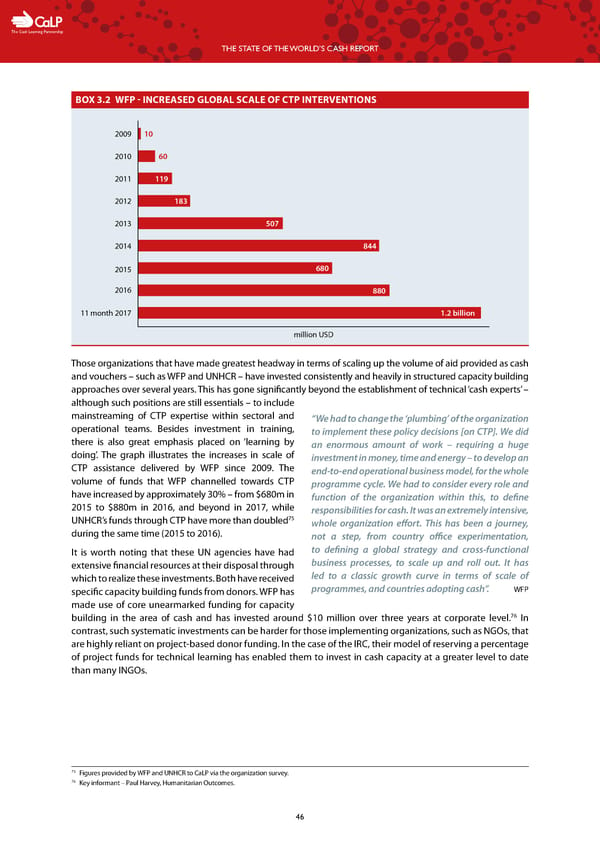C The Cash Learning Partnership THE STATE OF THE WORLD’S CASH REPORT BOX 3.2 WFP - INCREASED GLOBAL SCALE OF CTP INTERVENTIONS CBT Trend 2009–2017 (11 month) 2009 10 2010 60 2011 119 2012 183 2013 507 2014 844 2015 680 2016 880 11 month 2017 1.2 billion Source: WINGS/BO million USD Those organizations that have made greatest headway in terms of scaling up the volume of aid provided as cash and vouchers – such as WFP and UNHCR – have invested consistently and heavily in structured capacity building approaches over several years. This has gone significantly beyond the establishment of technical ‘cash experts’ – although such positions are still essentials – to include mainstreaming of CTP expertise within sectoral and “We had to change the ‘plumbing’ of the organization operational teams. Besides investment in training, to implement these policy decisions [on CTP]. We did there is also great emphasis placed on ‘learning by an enormous amount of work – requiring a huge doing’. The graph illustrates the increases in scale of investment in money, time and energy – to develop an CTP assistance delivered by WFP since 2009. The end-to-end operational business model, for the whole volume of funds that WFP channelled towards CTP programme cycle. We had to consider every role and have increased by approximately 30% – from $680m in function of the organization within this, to define 2015 to $880m in 2016, and beyond in 2017, while responsibilities for cash. It was an extremely intensive, UNHCR’s funds through CTP have more than doubled75 whole organization effort. This has been a journey, during the same time (2015 to 2016). not a step, from country office experimentation, It is worth noting that these UN agencies have had to defining a global strategy and cross-functional extensive financial resources at their disposal through business processes, to scale up and roll out. It has which to realize these investments. Both have received led to a classic growth curve in terms of scale of specific capacity building funds from donors. WFP has programmes, and countries adopting cash”. WFP made use of core unearmarked funding for capacity 76 building in the area of cash and has invested around $10 million over three years at corporate level. In contrast, such systematic investments can be harder for those implementing organizations, such as NGOs, that are highly reliant on project-based donor funding. In the case of the IRC, their model of reserving a percentage of project funds for technical learning has enabled them to invest in cash capacity at a greater level to date than many INGOs. 75 Figures provided by WFP and UNHCR to CaLP via the organization survey. 76 Key informant – Paul Harvey, Humanitarian Outcomes. 46
 The State of the World's Cash | Full Report Page 47 Page 49
The State of the World's Cash | Full Report Page 47 Page 49